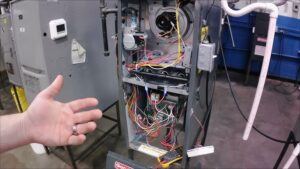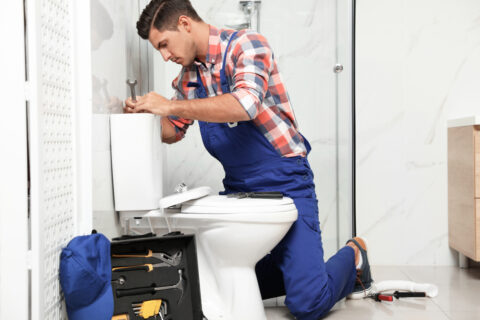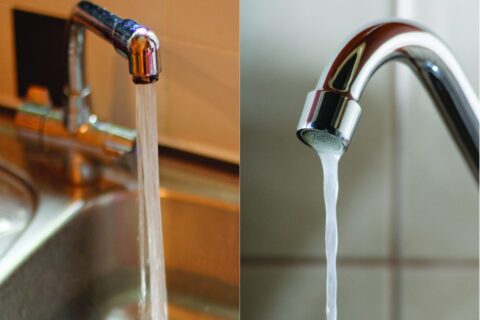Furnace Short Cycling: Causes and Solutions Explained
Key Takeaways
-
Furnace short cycling is when your heating system turns on and off repeatedly. This leads to inefficient heating and even potential damage to the system.
-
Some common culprits include thermostat issues, clogged air filters, and oversized furnaces.
-
Short cycling can increase your energy bills. It can also shorten your furnace’s lifespan, so it’s important to address this problem sooner rather than later.
-
You can usually address short cycling by cleaning or replacing the air filters. Don’t neglect to check your thermostat settings and ensure your furnace is the correct size, too!
-
Ongoing maintenance—including regular inspections and cleaning—can stop short cycling before it happens and help your furnace run smoothly.
-
If short cycling persists after troubleshooting, call a professional HVAC technician. They will perform a detailed inspection and the repairs you require.
Your furnace misbehaves by shutting down prematurely. This issue, known as short cycling, disrupts heating and can spike energy bills.
Common causes of short cycling include dirty filters, thermostat issues, or oversized units. These hiccups not only waste energy but can also shorten your furnace’s lifespan.
Fortunately, you can correct some of these problems yourself. Simply cleaning the filters or checking the thermostat can make a significant difference. Regular maintenance and care help keep your furnace running smoothly.
However, sometimes the issue may require a professional’s touch. If basic troubleshooting doesn’t resolve the problem, it might be time to call in an expert.
We know that furnace problems can seem like a mystery. However, with a little know-how, you can get back on track.
In this guide, we will delve into the nitty-gritty of short cycling and provide tips to combat it. We’ll also inform you about when it’s time to call in the experts.
With your help, you’ll have a comfy, streamlined home in no time. Let’s get to the bottom of the short cycling puzzle with your furnace.
What is Furnace Short Cycling?
Your furnace keeps cycling on and off very frequently. It just isn’t going to get to that comfortable temperature you’ve selected on your thermostat.
Imagine it like this: you’re trying to heat up your living room, but your furnace just can’t seem to stick around long enough to get the job done.
It’s kind of like a game of tag, but not in a fun way!
Now, why should you care? Short cycling means that you’re not getting the efficient heating you deserve.
That’s because instead of warming your home evenly, it’s using more energy than necessary — and that drives up energy bills. Nobody wants that, right?
Normally, a furnace should run for about 15 minutes per cycle to slowly nudge up the temperature. However, when it short cycles, it could be running only a few minutes, and that’s just not enough.
Here’s a quick list to help you understand the cycle differences:
-
Length of Cycle: Different cycles vary in duration. For example, a business cycle typically lasts several years, while a seasonal cycle may only span a few months.
-
Phases: Each cycle consists of distinct phases. In a business cycle, you might see expansion, peak, contraction, and trough, whereas a seasonal cycle includes periods like spring, summer, fall, and winter.
-
Causes: The factors driving these cycles differ significantly. Economic cycles are influenced by market forces, consumer behavior, and government policies, while seasonal cycles are often dictated by climatic changes and agricultural patterns.
-
Impact on Stakeholders: The effects of these cycles can vary for different stakeholders. For instance, businesses may adjust their strategies based on economic cycles, while farmers plan their activities around seasonal cycles.
-
Predictability: Some cycles are more predictable than others. Seasonal cycles tend to follow a regular pattern, while economic cycles can be more erratic and influenced by unforeseen events.
Understanding these differences can help you navigate various contexts more effectively.
-
Normal Cycle Duration: Around 15 minutes
-
Short Cycle Duration: Just a few minutes
-
Typical Cycles Per Hour: 3 to 8 times
Furnaces in good shape and correctly sized for your home cycle three to eight times per hour. Monitor their performance to make sure they aren’t wasting time!
During colder months, you may see your furnace run more frequently, which is typical. However, short cycling is a red flag.
Short cycling can lead to wear and tear on important components. Think of your furnace like a car engine. If it keeps starting and stopping, it will wear out a lot faster than if it runs smoothly.
Short cycling isn’t merely a bothersome quirk. It may snowball into some serious issues as you lose more money on repairs and replacements in the long run.
Keep your eyes peeled and nip problems in the bud. This way you don’t give yourself any massive headaches at the end.
Causes of Furnace Short Cycling
Knowing why your furnace short cycles keeps your home warm.
It also manages your energy bills well.
Let’s jump into this common culprit and how you can approach it.
Dirty Air Filters
Changing your air filters regularly is like giving your furnace a fresh breath of air. Dirty filters restrict airflow, causing the furnace to overheat and shut down in an attempt to protect itself. This phenomenon is known as short cycling.
Imagine trying to breathe through a straw; that’s what your furnace is doing with clogged filters. To prevent this, we change the filters monthly, especially during winter, which significantly helps maintain efficiency.
Additionally, it’s important to use decent filters to ensure that the furnace operates really well. Quality filters can make a noticeable difference in the overall performance and longevity of your heating system.
Faulty Thermostat
A thermostat that misreads what’s going on in the room will make that furnace of yours act up; it will turn on and off at will. If you have an older thermostat (over 10 years old), it’s time to upgrade.
Modern, programmable thermostats provide precision control. They can help maintain a consistent temperature and improve energy efficiency in your home.
Additionally, it’s important to place the thermostat away from heat sources, such as windows or lamps, to prevent inaccurate readings. If these controls aren’t correctly calibrated, the operation won’t be smooth. Proper placement and calibration are essential for optimal performance.
Air Leaks in Ducts
Air leaks in your duct work are like leaving windows open when the heater’s on. These leaks mess with airflow, causing uneven heating and short cycling.
Having sealed your ducts is a must if you want to keep your home warm and energy-efficient. Inspect your ducts regularly and seal leaks with duct tape or mastic sealant.
Malfunctioning Components
Worn or busted parts, such as the flame sensor and blower motor, are troublemakers for your heating system. These components play crucial roles in ensuring the furnace operates efficiently and safely.
The fan limit switch is another important part that helps prevent the furnace from overheating. When this switch functions correctly, it maintains a safe operating temperature, protecting the system from potential damage.
Regular checks of these components can catch problems early, saving you a headache later. By being proactive with maintenance, you can avoid costly repairs and ensure your furnace runs effectively.
If you notice any faulty parts, it’s essential to replace them quickly. This prompt action will help keep your heating system running smoothly and efficiently throughout the colder months.
Incorrect Furnace Size
A furnace that’s too big for where you live is like using a sledgehammer to crack a nut. It heats too fast, shutting off often.
A furnace should cycle three to eight times per hour, averaging about 15 minutes per cycle. If yours is not cycling properly, a Manual J Load Test can find what’s right for you.
DIY sizing mistakes can be costly; therefore, it’s advisable to consult with HVAC professionals.
Blocked Exhaust Flue
A blocked exhaust flue leads to overheating, and that’s a fire hazard. Debris or animal nests are common causes of such blockages.
Regular cleaning ensures safe operation and prevents short cycling. Keeping your exhaust pathways clear is a safety must.
Effects on Heating Efficiency
Short cycling is like a little gremlin for your heating system. When your furnace keeps turning on and off, it’s not just annoying—it messes with efficiency.
It uses more energy than it should, sending those bills right up. It’s the same thing as running up and down stairs all day; your furnace feels the same. This constant start and stop can raise energy bills by as much as 20%. Ouch!
It’s not all about the money, of course. It’s about getting the heat you pay for.
Now let’s talk about wear and tear. A furnace that’s constantly “on the move,” turning on and off again and again, gets a real beating.
Think of it like a car stuck in traffic. The more you stop and start, the sooner you wear out the engine. The same goes for furnace parts.
Regular cycling can wear down parts more quickly, resulting in expensive repairs or even premature replacement. Trust me—it can get expensive to do something wrong when you’re making a DIY mistake.
Do it wrong, and you may find yourself with costly replacement.
What about those cold evenings? When your furnace short cycles, it doesn’t run long enough to heat your home properly.
Some rooms may be cold while others get stuffy, making it difficult to feel comfortable. That’s because short cycles don’t allow your system to distribute heat evenly.
You want a nice, even warmth, not a patchy one.
One way to catch short cycling early is to monitor your energy bills. If you notice a sudden spike, your furnace may need inspecting.
Keep in mind that during the colder months, your furnace should work harder. However, it should not cycle more than eight times an hour.
A typical cycle ranges from seven to 20 minutes. If your furnace is flipping more than that, something’s up.
Here’s a quick look at normal furnace behavior:
|
Cycles Per Hour |
Normal Range |
|---|---|
|
Cycles |
3 to 8 |
|
Cycle Length |
7 to 20 mins |
Solutions to Fix Short Cycling
Getting your furnace back on track is doable with these steps.
While short cycling, where your furnace frequently turns on and off, is frustrating, there’s good news.
Let’s get into how you can correct this.
1. Replace Air Filters
Changing the air filters makes all the difference. Dirty filters clog up the airflow and make your furnace work harder, which is no good.
Try to replace them every three months. The higher the MERV rating, the more dust and particles the filter will catch, leading to better air quality.
Put reminders on your phone for a quick nudge. Clearer filters also mean better efficiency and less cycling.
2. Adjust Thermostat Settings
Check your thermostat settings—it’s easy to overlook. Program it to fit your daily routine. This saves energy and keeps your home cozy.
If your thermostat is battery-operated, change the batteries every six months. Smart thermostats give you even greater control, allowing you to power up and down remotely.
If you are moving the thermostat, you’ll need to rewire it accordingly.

3. Seal Duct Leaks
Leaky ducts are a well-hidden culprit. Look for cracks and seal them up with duct tape or mastic.
You can also hire pros for a more thorough job. Sealed ducts mean consistent heating, so your furnace won’t work overtime.
To spot leaks, use a flashlight and listen for whistling noises.
4. Repair or Replace Parts
Watch for furnace parts. Components that aren’t working right require immediate fixes.
Make a checklist of parts to inspect, such as the igniter and flame sensor. If parts are faulty, decide whether to repair or replace them.
The spares will free up your time. If you keep looking, you can save yourself some expensive fixes.
5. Evaluate Furnace Size
Is your furnace the right size? An oversized furnace cycles too often, which can lead to inefficiencies and increased wear and tear on the system.
To determine the correct size for your furnace, it’s advisable to consult with HVAC professionals who can provide a more accurate assessment based on your specific needs.
If you find that your furnace does need replacing, consider investing in energy-efficient models.
A properly sized furnace not only ensures better performance but also results in fewer cycles, ultimately saving you money on energy bills and extending the lifespan of the unit.
6. Clear Obstructions in Flue
The flue needs to breathe. Blockages can be dangerous, leading to carbon monoxide building up.
Check on it regularly, particularly after storms. Wear gloves for safety and protection.
Keeping it clear protects you and allows your furnace to run smoothly.
If problems continue, talking with HVAC pros like GAC Services is prudent.
They’re fast and dependable in Maryland.
Maintenance Tips for Furnaces
Taking care of your furnace doesn’t have to feel like a chore.
Doing basic maintenance helps your system run smoothly and efficiently. This not only saves you money but also keeps your home cozy.
Regular Inspection Schedule
To start, discuss the inspection schedule. You have to have a routine to catch any hiccups before they become big problems.
As winter approaches, setting up seasonal inspections is wise. That way, you’re not scrambling for repairs when you need heat the most.
A simple checklist can help: check the filter, look for leaks, and listen for weird noises. Catching small problems early prevents them from becoming expensive repairs later.
Cleaning and Servicing
Cleaning’s another biggie. A clean furnace works better and lasts longer. Dust and grime can mess with parts, leading to inefficient cycles.
You should replace or clean the filter every one to three months. While it’s an easy DIY job, you may want to call in the professionals for deep cleaning. They can get into those pesky places and ensure you’re all clean.
Regular servicing boosts safety and keeps performance high, so it’s worth it.
Monitor Thermostat Function
The thermostat is your furnace’s brain, so to speak. If it’s off, everything’s off.
Verify its accuracy regularly by comparing it to a standalone thermometer. If the readings don’t line up, you may need a recalibration or even a new thermostat.
Keeping tabs on it helps ensure your system doesn’t work harder than necessary. This not only saves energy but also keeps everything running smoothly.
Here’s a quick checklist to keep on hand:
-
Clean or replace the filter every 1-3 months.
-
Schedule seasonal inspections, especially before winter.
-
Check thermostat accuracy regularly.
-
Address any unusual noises or leaks immediately.
By monitoring these simple maintenance tasks, you can significantly improve your furnace’s efficiency. This attention will also lessen how often it needs repairs.
A standard cycle should take around 10 to 15 minutes. If it’s cycling every couple of minutes, that means you’re short cycling.
Now it’s time for you to take action!
When to Seek Professional Help
Persistent Short Cycling Issues
Have you attempted to fix your furnace’s short cycling yourself but can’t seem to remedy the issues? It’s time to bring in the pros for backup! Furnaces typically kick on and off between three to eight times an hour. If yours is being erratic, running only a few minutes before shutting down, something else is likely going on.
This is where a professional evaluation comes into play. They have the expertise to discover problems that you might not even know about, such as a poorly sized furnace. Shockingly, only 1 in 5 homeowners have a furnace that fits their home properly!
You can help your technician by taking notes about any weird symptoms or patterns you notice. This information will be really useful to them in order to effectively troubleshoot. Don’t wait too long, either. If you can get someone in early, it can prevent a small hiccup from becoming a big, costly mess.
Electrical System Concerns
Your furnace isn’t just about heat—there’s an electrical side, too. At times, short cycling can be attributed to these electrical components.
First, check your circuit breakers and fuses. If you see something, say something—or get the opinion of a professional. Some electrical problems can be hazardous or even damage your furnace.
It’s wise to have an expert take a look. They’ll know what to look for and how to check it’s all in order.
Complex Component Repairs
Sometimes your furnace requires some serious TLC with all its complicated parts. These aren’t your typical DIY projects. Fixing things such as the heat exchanger or blower motor can be dangerous if you do not have the skills to do so.
Instead, turn these intricate repairs over to trained technicians. They have the experience to identify and address issues without cutting corners on safety. When you have professionals working on your furnace, it’s going to keep running smoothly and reliably.
Quick Tips for Furnace Maintenance
-
Keep a log of any strange furnace behavior.
-
Check Electricals: Don’t ignore circuit breakers or fuses.
-
Seek help for complex part repairs.
Conclusion
Furnace short cycling isn’t just a little hiccup. It messes with your heating and costs you money. Fixing it? Not rocket surgery. Check filters, vents, and thermostat. Sometimes, you gotta call in the pros. You can do so much yourself.
Regular check-ups keep the furnace happy. Keep filters clean and vents clear, and look out for trouble. Like any machine, it needs love and care. If things uncomfortably heat up, don’t sit back. Call in the expert to put things right.
Go ahead, roll up those sleeves. Dig into that furnace maintenance, save a few bucks, and keep your place warm. Want more handy tips or need help? Get out and reach out. We’re here to help you figure it out and keep it comfy.
Frequently Asked Questions
What is furnace short cycling?
Furnace short cycling is when your furnace starts and stops frequently. This interrupts the heating process. It could be a problem with the system. Taking care of it quickly will bring everything back to comfortable and efficient.
What causes furnace short cycling?
Common causes include a clogged air filter, thermostat issues, or oversized furnaces. Each of them affects the performance of your system. The cause helps you troubleshoot and repair it effectively.
How does short cycling affect heating efficiency?
Short cycling lowers heating efficiency. It stops the furnace from completing its full heating cycle. This causes higher energy consumption and raises utility bills. Doing so addresses the issue and saves money and energy.
How can I fix furnace short cycling?
Begin by inspecting and replacing the air filter. Make sure the thermostat is working properly. If issues continue, then you’ll want to contact a professional inspector. Quick action limits damage and gets things back to efficient.
What maintenance tips can prevent short cycling?
What you need is routine maintenance. Replace air filters every 1-3 months, check thermostat settings, and schedule annual professional inspections. This ensures that you are achieving the best performance and helps prevent short cycling.
When should I seek professional help for short cycling?
If basic solutions aren’t working, get professional help. Persistent short cycling may point to more serious issues. A certified technician can identify and rectify complex issues, prolonging your furnace’s lifespan.
Why is it important to address furnace short cycling?
Correcting short cycling improves comfort levels, decreases energy expenses, and increases the longevity of your furnace. It will protect against any additional damage and ensure reliable operation. Timely intervention saves money and keeps a home comfortable.


